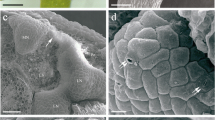Summary
Studies in Costa Rica on two ornithophilous flowers, Justicia aurea (Acanthaceae) and Columnea glabra (Gesneriaceae) showed a constancy of nectar solute concentrations that was attributed to microclimatic protection by the tubular corolla and to copious nectar secretion, helped by waterproofing by a lipid film on the nectar surface in Justicia and by preferential compass orientation of the flowers of Columnea.
Most of the corollas in the patch of Justicia had been pierced by nectar-robbers. A consequence of this damage, together with local microclimate effects, was flower-to-flower variation in the amount and accessibility of nectar and in the nature and concentration of its minor components, notably amino acids.
McDade and Kinsman's (1980) finding that nectar secretion could be suppressed by repeated sampling or by nectar-robbing was confirmed.
Similar content being viewed by others
References
Baker HG (1978) Chemical aspects of the pollination biology of woody plants in the tropics. In: PB Tomlinson, MH Zimmerman (eds) Tropical trees as living systems, Cambridge University Press
Baker HG, Baker I (1973) Amino acids in nectar and their evolutionary significance. Nature, Lond 241:543–545
Berkeley Earl of, Hartley EGJ, Burton CV (1919) On osmotic pressures derived from vapour pressure measurements: aqueous solutions of cane sugar and methyl glucoside. Philosophical Transactions of the Royal Society A 218:295–349
Betts AD (1930) The ingestion of syrup by the honey bee. Bee World 11:85–90
Bolten AB, Feinsinger P (1978) Why do hummingbird flowers secrete dilute nectar? Biotropica 10:307–309
Corbet SA, Unwin DM, Prys-Jones OE (1979) Humidity, nectar and insect visits to flowers, with special reference to Crataegus, Tilia and Echium. Ecological Entomology 4:9–22
Corbet SA, Willmer PG, Beament JWL, Unwin DM, Prŷs-Jones OE (1979) Post-secretory determinants of sugar concentration in nectar. Plant Cell and Environment 2:293–308
Feinsinger P (1978) Ecological interactions between plants and hummingbirds in a successional tropical community. Ecological Monographs 48:269–287
Gieger R (1965) The climate near the ground. Cambridge Mass Harvard University Press.
Inouye DW (1980) Terminology of floral larceny. Ecology 61:1251–1253
Inouye DW, Favre ND, Lanum JA, Levine DM, Meyers JB, Roberts MS, Tsao FC, Wang Y-Y (1980) The effects of non-sugar constituents on estimates of nectar energy content. Ecology 61:992–997
Jones CE, Rich PV (1972) Ornithophily and extrafloral color patterns in Columnea florida Morton (Gesneriaceae). Bulletin of the Southern California Academy of Sciences 71:113–116
Kevan PG (1975) Sun-tracking solar furnaces in High Arctic flowers: significance for pollination and insects. Science 189:723–726
McDade LA, Kinsman S (1980) The impact of floral parasitism in two neotropical hummingbird-pollinated plant species. Evolution 34:944–958
Percival M (1961) Types of nectar in angiosperms. New Phytologist 60:235–281
Pouvreau A (1974) Le comportement alimentaire des bourdons (Hymenoptera Apoidea, Bombus Latr.): la consommation de solutions sucrées. Apidologie 5:247–270
Stiles FG (1976) Taste preferences, colour preferences, and flower choice in hummingbirds. Condor 78:10–26
Unwin DM (1980) Microclimate measurement for ecologists. Academic Press, London
Unwin DM, Willmer PG (1978) A simple field cryoscope-osmometer for freezing-point determination with small fluid samples. Physiological Entomology 3:341–345
Willmer PG (1980) The effects of insect visitors on nectar constituents in temperate plants. Oecologia (Berl) 47:270–277
Willmer PG, Corbet SA (in press) Temporal and microclimatic partitioning of the floral resources of Justicia aurea amongst a concourse of pollen vectors and nectar robbers. Oecologia (Berl)
Author information
Authors and Affiliations
Rights and permissions
About this article
Cite this article
Corbet, S.A., Willmer, P.G. The nectar of Justicia and Columnea: Composition and concentration in a humid tropical climate. Oecologia 51, 412–418 (1981). https://doi.org/10.1007/BF00540915
Received:
Issue Date:
DOI: https://doi.org/10.1007/BF00540915




